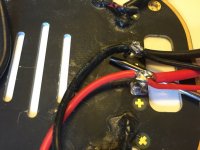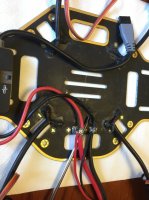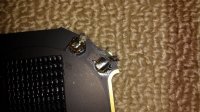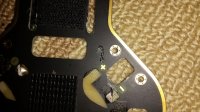Gary Seven
Rocketman
Hello everyone. Well, it had to happen sooner or later, so I guess last night was my turn. It was one of those perfect sunset evenings here with no wind and clear skies. So I got out my F450 and decided to run it more or less full throttle in an oblong course with my custom LED's and strobes lighting her up as well.
After about 14 minutes of this, my wife pulls up in the car to talk to me, so I put my quad in GPS mode and just let it sit there hovering (at about 50m altitude) while discussing what to buy at the the supermarket. At that moment, I hear my voltage alarm going off so I turn to look up and bring my machine down. It then instantly drops like a lead weight, falling into my neighbor's yard and breaking all four arms plus two ESC's (and I assume, the motors as well). From my point of view it clearly looked like a cell failure.
Because I just received a new iCharger 406duo last week, I was able to take IR measurements on my batteries whilst tinkering with it and exploring its various functions. I'd like to get an opinion or two on the IR readings I took on this battery last week and then after the accident today.
Zippy FlightMax 4000 maA, 20C, 3S. Approx. 30 flights
IR (mΩ) last week: 3.5, 3.6, 2.7
IR (mΩ) today: 4.8, 9.2, 6.9
Does anyone else concur that cell-2 in my 3S battery failed?
Anyway, FWIW to anyone from an education standpoint, this failure was brought on by the pilot (me) not using good LiPo management practices. As a matter of fact, it was last week when I ran this very same battery way down (had my voltage alarm set at 3.4V instead of my usual 3.6V), and upon recharge it took 4000mA! Yep, I ran it down, damaged a cell, proceeded to run my F450 through a full throttle course for almost 15 minutes on the SAME battery, and as a result lost my beautiful, light customized machine which I spent hours and hours tricking out and fine tuning.
Just a word to the inexperienced and new fliers out there: Treat your LiPo's with kid gloves and be good to them. A cell failure in a single, non-parallel setup will destroy your bird at altitude, or you may lose it altogether!
Going to start another thread with some questions on a hex build. Thanks for reading this.
After about 14 minutes of this, my wife pulls up in the car to talk to me, so I put my quad in GPS mode and just let it sit there hovering (at about 50m altitude) while discussing what to buy at the the supermarket. At that moment, I hear my voltage alarm going off so I turn to look up and bring my machine down. It then instantly drops like a lead weight, falling into my neighbor's yard and breaking all four arms plus two ESC's (and I assume, the motors as well). From my point of view it clearly looked like a cell failure.
Because I just received a new iCharger 406duo last week, I was able to take IR measurements on my batteries whilst tinkering with it and exploring its various functions. I'd like to get an opinion or two on the IR readings I took on this battery last week and then after the accident today.
Zippy FlightMax 4000 maA, 20C, 3S. Approx. 30 flights
IR (mΩ) last week: 3.5, 3.6, 2.7
IR (mΩ) today: 4.8, 9.2, 6.9
Does anyone else concur that cell-2 in my 3S battery failed?
Anyway, FWIW to anyone from an education standpoint, this failure was brought on by the pilot (me) not using good LiPo management practices. As a matter of fact, it was last week when I ran this very same battery way down (had my voltage alarm set at 3.4V instead of my usual 3.6V), and upon recharge it took 4000mA! Yep, I ran it down, damaged a cell, proceeded to run my F450 through a full throttle course for almost 15 minutes on the SAME battery, and as a result lost my beautiful, light customized machine which I spent hours and hours tricking out and fine tuning.
Just a word to the inexperienced and new fliers out there: Treat your LiPo's with kid gloves and be good to them. A cell failure in a single, non-parallel setup will destroy your bird at altitude, or you may lose it altogether!
Going to start another thread with some questions on a hex build. Thanks for reading this.




